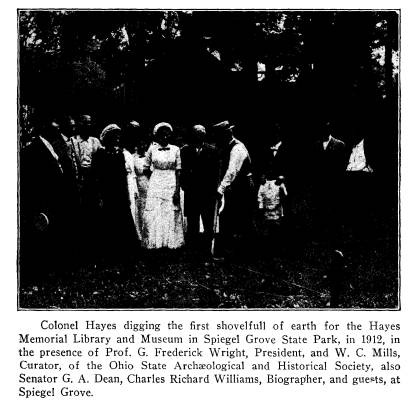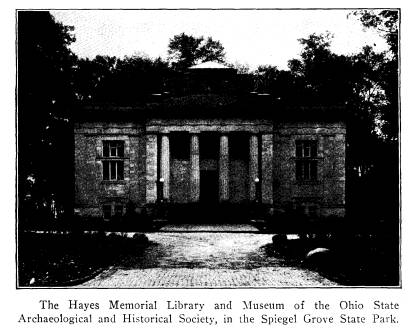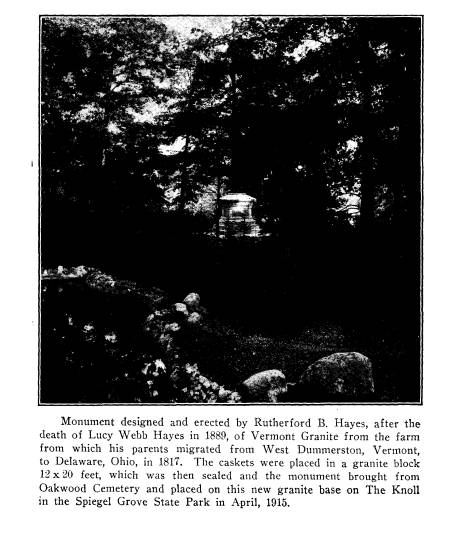Ohio History Journal
- 1
- 2
- 3
- 4
- 5
- 6
- 7
- 8
- 9
THE HAYES BEQUESTS.
When future generations shall make their
pilgrimages to
the historic scenes of Fremont, Ohio,
they will ask "What means
this beautiful park with its winding
roads through a forest of
gigantic trees, and this artistic
building of stone at its northern
entrance, with this commodious, but
simple brick mansion in
the background; and what is this
magnificent collection of build-
ing in a spacious field outside,
approached by well-worn roads
and pathways?" The answer will be,
"This park is Spiegel
Grove, an area of twenty-five acres,
still covered with the orig-
inal forest except where spaces have
been cleared for the home
of General Rutherford B. Hayes, one of
the most eminent presi-
dents of the United States. This winding
roadway, with its
depression where crossing a brooklet, is
a portion of the original
Indian trail from the Great Lakes to the
Ohio River, trod for
ages by countless feet of the aboriginal
inhabitants of America,
and followed in 1813 by General
Harrison's army on its road to
victory in the battle of the Thames.
This "poem in stone" is a
monument to President Hayes, erected by
the Ohio State Arch-
aeological and Historical Society with
funds furnished by the
Legislature, and holding the great
library of Americana col-
lected by President Hayes, together with
his military and po-
litical correspondence, and a general
collection of family and his-
toric relics-altogether, "a thing
of beauty and a joy forever."
Each of the four entrances to the park
has a character of
its own. The main entrance from the
street at the northeast,
through a gateway adorned by massive
walls of granitic bowlders
from Canada, transported to the near
vicinity thousands of
years ago by the slow-moving ice of the
glacial period, was
erected by Colonel Webb C. Hayes, the
dutiful son of President
Hayes; as was also the northwestern
entrance, between gigantic
cannon standing on end, and flanked by
massive granitic walls
constructed of glacial bowlders and
bearing inscriptions in mem-
ory of the officers and soldiers from
the vicinity who took part
(591)
592
Ohio Arch. and Hist. Society
Publications.
in the Mexican and Civil wars; and the
south entrance, likewise
guarded by immense cannon standing on
end, supported also
by granitic walls of glacial bowlders,
and bearing inscriptions
in memory of General Harrison's army,
which passed over the
trail in 1813, was erected by Col.
Hayes. This cluster of build-
ings in the ample grounds outside is a
hospital erected by a
generous gift of the wife of Colonel
Webb C. Hayes, and en-
dowed by a fund raised by subscriptions
among the citizens of
the town and vicinity.
That it is not necessary for the
interest of history to make
it a mere record of wars, strifes, and
calamities appeared in a
striking manner in the events which
culminated in Fremont,
Ohio, October 21, 1915, when the saying of Montesquieu,
"Happy are the people whose annals
are tiresome," was shown
to be true only so far as historians
fail in their opportunity to
present the bright side of the picture.
That evening witnessed a scene in the
Hayes Memorial
Library unprecedented in the town or
indeed in northern Ohio.
The occasion which called the people
together was the comple-
tion of the effort to raise $100,000 by
the citizens to secure the
conditional gift of the same amount by
Mrs. Webb C. Hayes
for the erection and equipment of a
hospital. In celebration of
this event a general reception was held
under the dome of the
Library. It was not a dress affair but
everybody came, re-
publicans and democrats, rich and poor,
Catholics and Protes-
tants, Jews and Gentiles, and every face
was beaming with de-
light. One poor widow's house was
entered by the solicitors
by mistake, but she would not let them
go without contributing
a dime. This aroused more interest than
did the largest gift
by others of ample means. Another poor
widow insisted on
giving a slender gold ring which she
valued as a keepsake from
her childhood. This was put up at
auction and sold for $100
and the ring given back to her. All that
one man could give was
three bushels of potatoes. They were put
up at auction and
sold for $27. To crown it all Professor
G. Frederick Wright,
President of the Ohio State
Archaeological and Historical So-
ciety, was permitted to announce that
Colonel Webb C. Hayes
had that day turned over to a trust
society in Cleveland, $50,000,
|
The Hayes Bequests. 593 the income of which was perpetually to be used in purchasing books and historical material for the Hayes Memorial Library in the line of those collected by his father. He was also per- mitted to announce that since Colonel Hayes had deeded the Spiegel Grove property to the state in care of the Archaeo- logical and Historical Society he had spent $50,000 in building |
|
|
|
the gateways, removing to the grounds his father's monument with the remains of his father and mother, improving the family mansion and the property in general, and in the addition of many features to the Memorial Building not provided for by the State appropriation, which, in addition to the $50,000 appro- Vol. XXIV-38 |
594 Ohio Arch. and Hist.
Society Publications.
priated by the State and the property
value of Spiegel Grove,
would make a sum equal to $300,000
contributed to the per-
petual benefit of the citizens of
Fremont, of the state of Ohio,
and to some extent of the world at
large.
After an introduction by Mr. J. M.
Sherman, chairman of
the Memorial Hospital campaign,
President Wright made the
following brief address:
The citizens of Fremont and vicinity
have great reason to
congratulate themselves upon the
accomplishments which have
this day been brought to pass in their
midst.
First, through the generosity of Mrs.
Webb C. Hayes, who
has contributed $100,000.00, and that of
numerous others, who
by gifts great and small have raised an
equal amount, you are
assured of a Hospital costing
$100,000.00 with an endowment
of another $100,000.
None but those who have traveled through
heathen lands
can fully realize the significance of
such a work of benevolence.
In India they have hospitals for sacred
cattle, but none for suf-
fering humanity. In China the afflicted
poor are left to perish
by the wayside. But it is one of the
most impressive products
of the influence of the words and
example of our Lord and
Master, Jesus Christ, that bodily wants
of the sick and suf-
fering poor are cared for by the
erection and maintenance in
Christian lands, of hospitals where
everything is done for them
that wealth has enabled the rich to do
for themselves.
In traveling through China, it is the
hospitals of the Medi-
cal Missionaries that impress one most
of all as displaying the
Christian spirit. As one passes into
Siberia, it is the hospitals
erected and endowed by generous Russian
citizens, full as much
as the churches, which show that one is
in a Christian land.
It is impossible to overestimate the
amount of peace and
satisfaction which is brought to the
poor by the thought that
if severe sickness or accident overtake
them, they are assured
of every care, in a nearby hospital,
that modern medical skill
can command.
Because of this hospital, life in
Fremont and Sandusky
County will be far more happy and
hopeful hereafter than it
has been in the past.
|
The Hayes Bequests. 595
Secondly: Of scarcely less value to the citizens of this town, and indeed of the state of Ohio and of the Nation, is the gift which I am now permitted to announce, by Colonel Webb C. Hayes for an endowment of the Hayes Memorial Library, the income of which is to be used in the purchase of historical material in the line of the rare collections of books in the library of the late President Hayes, now on the shelves of the |
|
|
|
beautiful fireproof building erected by the State as a memorial to your most distinguished citizen. The history of these gifts is most interesting. It was the original intention of Mrs. Hayes to give an endowment of $50,- ooo.oo to the Hayes Memorial Library, but at Colonel Hayes' suggestion she first offered it for the endowment of a hospital on conditions which have been satisfactorily met as a result of the present campaign, and now Colonel Hayes has carried out, |
596 Ohio Arch. and Hist.
Society Publications.
by his own gift of $50,000.00, the
original intention of Mrs.
Hayes.
Since his original gift of the Spiegel
Grove property, and
the appropriation by the Legislature of
$50,000 towards the
building of the fireproof Hayes Memorial
building, Colonel
Hayes has expended an equal amount in
cash on the Memorial
and Residence buildings, the Gateways
and the care and im-
provements of the Spiegel Grove
property, making a total cash
expenditure of over $100,000, which,
with the value of the per-
sonal and real estate, either deeded or
held in trust, makes a
total bequest of nearly $250,000.00 by
Colonel Hayes.
Fremont now has within its border an
educational prize
easily worth several hundred thousand
dollars. To this place
tourists will come from every part of
the land to feel the in-
spiration of this spot. Here will come
scholars from all parts
of the world to study the history of
mankind in America, and the
part which Rutherford B. Hayes played in
making the history
of this republic. And here perpetually
will the passing genera-
tions of the vicinity feel the ennobling
influence of these his-
torical monuments and of the cultured
atmosphere eminating
from the historical records and relics
housed in the Hayes Me-
morial Library.
Fortunate indeed is a community which
has a husband and
wife, each of whom is not only able but
willing to give
$100,000.00, the one for a Memorial
Library Museum and Park,
and the other for a Memorial Hospital,
both in honor to beloved
parents.
To crown it all Mrs. Webb C. Haves also
made another
offer to the city, wherein she provides
a Y. M. C. A. building
for the city. This fact was made known
in the following letter
from Mrs. Hayes:
SPIEGEL GROVE, FREMONT, OHIO,
October 18, 1915.
Mr. John M. Sherman, Chairman:
My Dear Mr. Sherman:-If you think it
would be of as-
sistance in securing subscriptions to
the Memorial Hospital Fund
you may say to the members of your
committee that if the move-
ment is successful and the committee
accepts Col. Hayes' offer
|
The Hayes Bequests. 597 |
|
|
598 Ohio Arch. and Hist.
Society Publications.
of some two acres towards a site for the
hospital, west of Spiegel
Grove, fronting on Buckland avenue, and
the additional acreage
required is secured, I will reserve the
Court street property
originally tendered by me for a hospital
site for some other
charitable or public purpose, such as a
Y. M. C. A. building,
headquarters for Boy Scouts, or other
suitable purpose, for the
benefit of the people of Fremont, and
further that if the Kridle-
and Childs properties on Buckland avenue
can be at once secured
for the hospital, I will turn over the
Chittenden double house or
the brick block for a temporary
headquarters for a Y. M. C. A.
building, to become a permanent gift
when suitable arrangements
for the erection of a permanent
structure have been made.
As you are aware it was originally my
intention to offer the
Court street property with the $25.000
in cash towards the hos-
pital building, and to give the $50,000
endowment portion of my
bequest to the Hayes Memorial Library in
Spiegel Grove to
match an almost equal amount of cash
which Col. Hayes has
expended on the buildings, gateways and
improvements in
Spiegel Grove since he presented it to
the state as a memorial
to his parents.
It was at Col. Hayes' suggestion,
however, that this $50,000
endowment should be tendered first for
the proposed hospital
and be available to it if within five
years certain conditions were
complied with. Since the preliminary
work was begun by your
committee he himself established on July
15 last a $50,000 cash
endowment fund for the Hayes Memorial
Library and Museum
in Spiegel Grove, the income from which
fund will annually be
used for the purchase of books and
objects of interest for that
institution which will be available to
the people of Fremont and
Sandusky county.
Very sincerely yours,
MARY MILLER HAYES.
Following the speech of Dr. Wright three
rousing cheers
were given the women for their valiant
work, and an in-
formal tour of the library and museum
was made. Those who
had not taken the opportunity before,
gazed with interest and
awe at the rare books, the wonderful
curios and valuable relics
The Haye's Bequests. 599
which have been garnered from the four
corners of the earth
and looked with reverence at the
personal possessions of our
beloved President Hayes and his equally
beloved wife, which
occupy such a prominent place among the
treasures of the
building. In each library room stood a
table imported from
Holland, bearing a vase of stately
chrysanthemums. It was
a sight never to be forgotten when the
guests gathered at the
Hayes home, where new and lasting
friendships formed dur-
ing the campaign were further cemented.
Upon this memorable
occasion, bitter rivalry was forgotten
and a spirit of fellowship,
to an extent never before realized in
Fremont, pervaded the
atmosphere.
The stately home, whose hospitality has
been graciously ex-
tended to so many distinguished guests
of national and interna-
tional fame, rich in its associations,
both historical and personal,
and with its wealth of rare paintings,
priceless rugs, foreign and
antique furniture, formed a proper
setting for this gathering
of men and women who had labored so
ceaselessly and untir-
ingly in the cause.
A buffet luncheon of sandwiches and
coffee, ices and cake
was served in the dining room. La France
roses graced the
center of the table. Assisting in the
pouring and throughout
the rooms were Mrs. M. Holderman, Mrs.
F. H. Door, Mrs. G.
F. Wright, of Oberlin; Mrs. Walter
Sherman, of Toledo; Mrs.
H. S. Buckland, Mrs. J. M. Sherman, Mrs.
C. R. Truesdall and
Miss Frances Pease. Mrs. Fanny Hayes
Smith, of Annapolis,
who has been quite ill for several
weeks, was able to greet friends
as they came upstairs.
THE HAYES BEQUESTS.
When future generations shall make their
pilgrimages to
the historic scenes of Fremont, Ohio,
they will ask "What means
this beautiful park with its winding
roads through a forest of
gigantic trees, and this artistic
building of stone at its northern
entrance, with this commodious, but
simple brick mansion in
the background; and what is this
magnificent collection of build-
ing in a spacious field outside,
approached by well-worn roads
and pathways?" The answer will be,
"This park is Spiegel
Grove, an area of twenty-five acres,
still covered with the orig-
inal forest except where spaces have
been cleared for the home
of General Rutherford B. Hayes, one of
the most eminent presi-
dents of the United States. This winding
roadway, with its
depression where crossing a brooklet, is
a portion of the original
Indian trail from the Great Lakes to the
Ohio River, trod for
ages by countless feet of the aboriginal
inhabitants of America,
and followed in 1813 by General
Harrison's army on its road to
victory in the battle of the Thames.
This "poem in stone" is a
monument to President Hayes, erected by
the Ohio State Arch-
aeological and Historical Society with
funds furnished by the
Legislature, and holding the great
library of Americana col-
lected by President Hayes, together with
his military and po-
litical correspondence, and a general
collection of family and his-
toric relics-altogether, "a thing
of beauty and a joy forever."
Each of the four entrances to the park
has a character of
its own. The main entrance from the
street at the northeast,
through a gateway adorned by massive
walls of granitic bowlders
from Canada, transported to the near
vicinity thousands of
years ago by the slow-moving ice of the
glacial period, was
erected by Colonel Webb C. Hayes, the
dutiful son of President
Hayes; as was also the northwestern
entrance, between gigantic
cannon standing on end, and flanked by
massive granitic walls
constructed of glacial bowlders and
bearing inscriptions in mem-
ory of the officers and soldiers from
the vicinity who took part
(591)
(614) 297-2300


